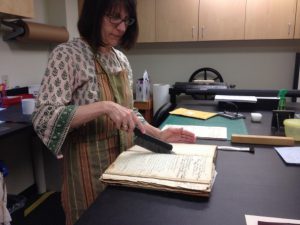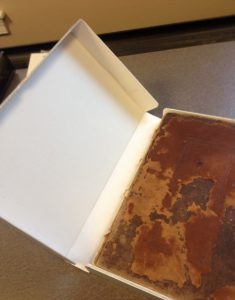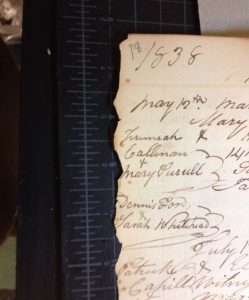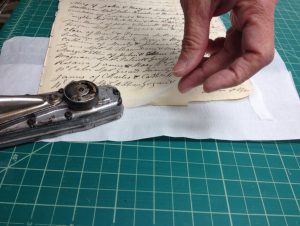If you have heard about our Historic Catholic Records Online project, in which NEHGS is digitizing and making accessible the sacramental records of the Roman Catholic Archdiocese of Boston, you might be wondering what has been happening over the past few months with the volumes that contain the records.
There is a regular supply of record volumes coming in and going out, and for those volumes in need of conservation, a lot can happen as they are prepared for scanning. Our Conservation Lab has received many volumes in seriously poor condition. Take, for example, this volume from Saint Patrick’s in Lowell, Massachusetts. It contains marriage records from 1836 to 1872.
Unfortunately, the paper used in this volume, and in many others, has aged poorly. I should add that the writing on some of these pages goes right up to the gutter and to the fore edge of the page. (There was nothing wasteful about these record keepers.) However, this manner of writing poses a serious problem when one wants to scan the pages. We don’t want to take a chance of breaking any text off the page. So how exactly do we treat these particular books?
 Our volunteer Dianne Wesselhoeft uses a static dissipating brush to collect the pieces of paper and dust from the gutter of a Saint Patrick volume.
Our volunteer Dianne Wesselhoeft uses a static dissipating brush to collect the pieces of paper and dust from the gutter of a Saint Patrick volume.
Well, first off, the technician checks for loose pieces that have broken off the edge of the page and collects what is salvageable and separates those from what small pieces are disposable. Then comes the matching game. It’s not always easy to find where a piece used to fit along the edge of a page, especially when you’re dealing with a sea of bits of paper.
And why did this happen in the first place? There are, after all, pages that are still sewn into the book and whose paper is without loss. The answer lies within the last sentence. That is, because certain sections of the book remained sewn in place, they remained free of damage. Loose pages sometimes stuck out beyond the protection of the cover. If the paper had been made of rags, linens, or cotton, the paper most likely would not have broken away from the sewing. The sewing in the book is still intact. The fault lies in the breakdown of the cellulose fiber of the paper.
[Because] certain sections of the book remained sewn in place, they remained free of damage.
The next question is, how do we make the pages user-friendly enough before we proceed with scanning? The traditional method is to use a high-quality mending paper such as Kizukishi. It is adhered with wheat paste such as zen shofu, and the consistency of the wheat paste needs to be rather thick – more so than the usual consistency we use, which is more like soupy Cream of Wheat.
Why thicker? Because if the paste is too wet, when the mending paper is applied (with wheat paste brushed on), it may cause tide lines. The tide lines are the brown lines that come through when moisture contacts the old paper, moving both accumulated dirt and sizing across the page. It looks bad and would further detract from the scanned image. As an alternative to thicker paste, we can use a substitute paper – Crompton Coated Tissue. This paper has a glossy and a non-glossy side, and is pH neutral. In the image at left, Dianne is using a tacking iron (a mini iron) and, with the glossy side face down on the page, she applies heat.
The majority of pages require that three sides of the page be lined with the heat-set tissue. For the Saint Patrick’s volume alone, there were approximately 85 pages to edge out. That’s a lot of ironing, and it took us two-and-a-half days to complete. But now the Saint Patrick’s volume is ready to scan.
 Once the scanning is complete, this volume will return to the lab so we can create a box for it. The box is a very simple but sound and utilitarian Phase Box, which is custom made for the size of the volume. For the spine of the box, a label is created which identifies the parish, its location, the type of records, and the dates of the records.
Once the scanning is complete, this volume will return to the lab so we can create a box for it. The box is a very simple but sound and utilitarian Phase Box, which is custom made for the size of the volume. For the spine of the box, a label is created which identifies the parish, its location, the type of records, and the dates of the records.
At this point, the volume can safely be returned to the Archives of the Roman Catholic Archdiocese of Boston, where it will be carefully stored. Researchers will have access to the online images of the records, reducing the handling of the original volumes and helping to avoid any need for additional conservation.
Share this:
About Deborah Rossi
Deborah Rossi is the Conservation Technician at NEHGS. She is responsible for the conservation and repair of the Society's book and manuscript collections. Deborah received her training at the North Bennet Street School in Boston.View all posts by Deborah Rossi →

